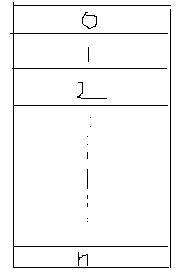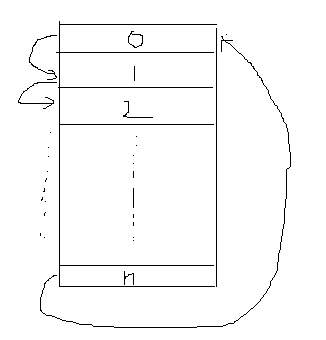链表-游标实现(C语言版)
2016-10-16 14:59
218 查看
如果用C/C++写链表的话,用指针会比较方便,但很多语言都没有指针,那么怎么实现比较好呢?游标是个不错的选择。
在用指针实现的链表中,有这样两个特点:
1.数据存在一组结构体中,并且每个结构体都有指向下一个结构体的指针。
2.一个新的结构体可以通过malloc获取内存,也可以用free来释放内存。
游标法也得满足这两个条件。满足条件1比较简单,用一个全局的结构体数组就行了;满足条件2的话可以保留一个表,如图:

0表示表头,然后他们的初始关系是这样这样:

当执行malloc功能时,我们把表头指向的单元拿出来使用,然后把表头指向下一个空单元,执行free功能时,将目标单元回收就行了。
这个表取名叫CursorSpace,下面给出CursorSpace的malloc和free的代码:
将代码和图结合起来试一试,应该很容易就能理解了。
下面给出完整代码:
1.头文件:
2。实现:
同样在最后加了个main函数来测试一下。
如果有错误,请积极指正。
注:代码改编自《数据结构与算法分析》第二版
在用指针实现的链表中,有这样两个特点:
1.数据存在一组结构体中,并且每个结构体都有指向下一个结构体的指针。
2.一个新的结构体可以通过malloc获取内存,也可以用free来释放内存。
游标法也得满足这两个条件。满足条件1比较简单,用一个全局的结构体数组就行了;满足条件2的话可以保留一个表,如图:

0表示表头,然后他们的初始关系是这样这样:

当执行malloc功能时,我们把表头指向的单元拿出来使用,然后把表头指向下一个空单元,执行free功能时,将目标单元回收就行了。
这个表取名叫CursorSpace,下面给出CursorSpace的malloc和free的代码:
static Position CursorAlloc(void)
{
Position P;
P = CursorSpace[0].Next;
CursorSpace[0].Next = CursorSpace[P].Next;
return P;
}
static void CursorFree(Position P)
{
CursorSpace[ P ].Next = CursorSpace[ 0 ].Next;
CursorSpace[ 0 ].Next = P;
}将代码和图结合起来试一试,应该很容易就能理解了。
下面给出完整代码:
1.头文件:
#ifndef CURSORLIST_H_INCLUDED #define CURSORLIST_H_INCLUDED typedef double ElementType; typedef int PtrToNode; typedef PtrToNode List; typedef PtrToNode Position; void InitializeCursorSpace( void ); List MakeEmpty(List L); int IsEmpty(const List L); int IsLast(const Position P,const List L); Position Find(ElementType X,const List L); void Delete(ElementType X,List L); Position FindPrevious(ElementType X,const List L); void Insert(ElementType X,List L,Position P); void DeleteList(List L); Position Header(const List L); Position First(const List L); Position Advance(const Position P); ElementType Retrieve(const Position P); #endif // CURSORLIST_H_INCLUDED
2。实现:
#include "CursorList.h"
#include <stdio.h>
#define SpaceSize 100
struct Node
{
ElementType Element;
Position Next;
};
struct Node CursorSpace[ SpaceSize ];
static Position CursorAlloc(void) { Position P; P = CursorSpace[0].Next; CursorSpace[0].Next = CursorSpace[P].Next; return P; } static void CursorFree(Position P) { CursorSpace[ P ].Next = CursorSpace[ 0 ].Next; CursorSpace[ 0 ].Next = P; }
/* Return true if L is empty */
int IsEmpty(List L)
{
return CursorSpace[L].Next == 0;
}
/* Return true if P is the last position in list L */
/* Parameter L is unused in this implementation */
int IsLast(Position P,List L)
{
return CursorSpace[P].Next == 0;
}
/* Return Position of X in L;0 if not found */
/* Uses a header node */
Position Find(ElementType X,List L)
{
Position P;
P = CursorSpace[ L ].Next;
while(P && CursorSpace[P].Element != X)
P = CursorSpace[P].Next;
return P;
}
/* Delete first occurrence of X in L; 0 if not found */
/* Assume use of a header node */
void Delete(ElementType X,List L)
{
Position P,TmpCell;
P = FindPrevious(X,L);
if(!IsLast(P,L))
{
TmpCell = CursorSpace[ P ].Next;
CursorSpace[ P ].Next = CursorSpace[ TmpCell ].Next;
CursorFree(TmpCell);
}
}
/* Insert (after legal position P) */
/* Header implementation assumed */
/* Parameter L is unused in this implementation */
void Insert(ElementType X,List L,Position P)
{
Position TmpCell;
TmpCell = CursorAlloc();
if(TmpCell == 0)
FatalError("Out of space!!!");
CursorSpace[TmpCell].Element = X;
CursorSpace[TmpCell].Next = CursorSpace[ P ].Next;
CursorSpace[P].Next = TmpCell;
}
/* initialize the CursorSpace */
void InitCursorSpace()
{
int i;
for(i = 0; i < SpaceSize; i++)
CursorSpace[i].Next = i==SpaceSize-1?0:i+1;
}
/* Find the front of the first X of The list */
/* Return 0 if not found */
Position FindPrevious(ElementType X,const List L)
{
Position P;
P = L;
while(P&&CursorSpace[CursorSpace[P].Next].Element != X)
P = CursorSpace[P].Next;
return P;
}
/* Do something when the fatal error occurred */
void FatalError(char * s)
{
printf("%s\n",s);
/* stop the program if necessary */
}
int main()
{
InitCursorSpace();
Li
4000
st a = CursorAlloc();
CursorSpace[a].Next = 0;
Insert(1,a,a);
Insert(0,a,a);
Insert(12.998,a,a);
Delete(12.998,a);
//Delete(0,a);
Position P = CursorSpace[a].Next;
printf("%lf\n",CursorSpace[P].Element);
}
同样在最后加了个main函数来测试一下。
如果有错误,请积极指正。
注:代码改编自《数据结构与算法分析》第二版
相关文章推荐
- 分别用数组和链表实现堆栈(C语言版) - ahljjun的专栏 - 博客频道 - CSDN.NET
- 链表的游标实现?
- [数据结构与算法分析] 链表的游标实现
- 数据结构之静态链表的游标表示及其实现(附完整代码)
- 链表的游标实现
- 单链表与顺序表的实现(C语言版)
- 链表游标实现
- 链表的游标实现
- 用链表实现一个简单的学生操作管理系统C语言版
- 链表的简单实现(C语言版)
- (C语言版)链表(一)——实现单向链表创建、插入、删除等简单操作(包含个人理解说明及注释,新手跟着写代码)
- 链表的游标实现(Java)
- 链表的游标(cursor)实现
- 【c++版数据结构】之用带头节点的单链表实现一元多项式(C语言版)
- (C语言版)链表(二)——实现单向循环链表创建、插入、删除、释放内存等简单操作
- 数组、链表实现栈(C语言版)
- (C语言版)链表(四)——实现双向循环链表创建、插入、删除、释放内存等简单操作
- 单链表的游标实现:插入、删除、查找、打印等功能
- c语言,顺序空间游标链表的实现
- 栈的链表实现(C语言版)
